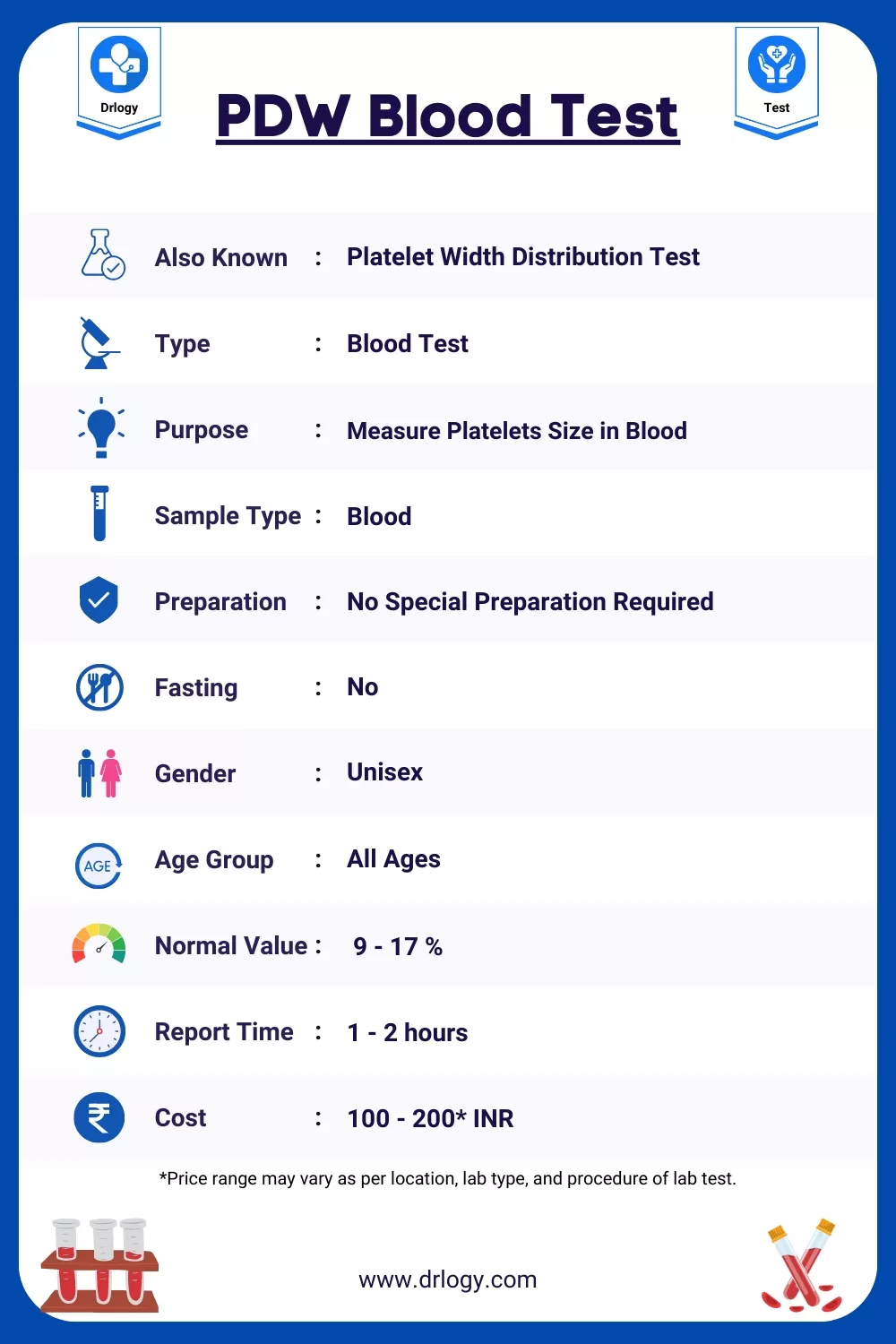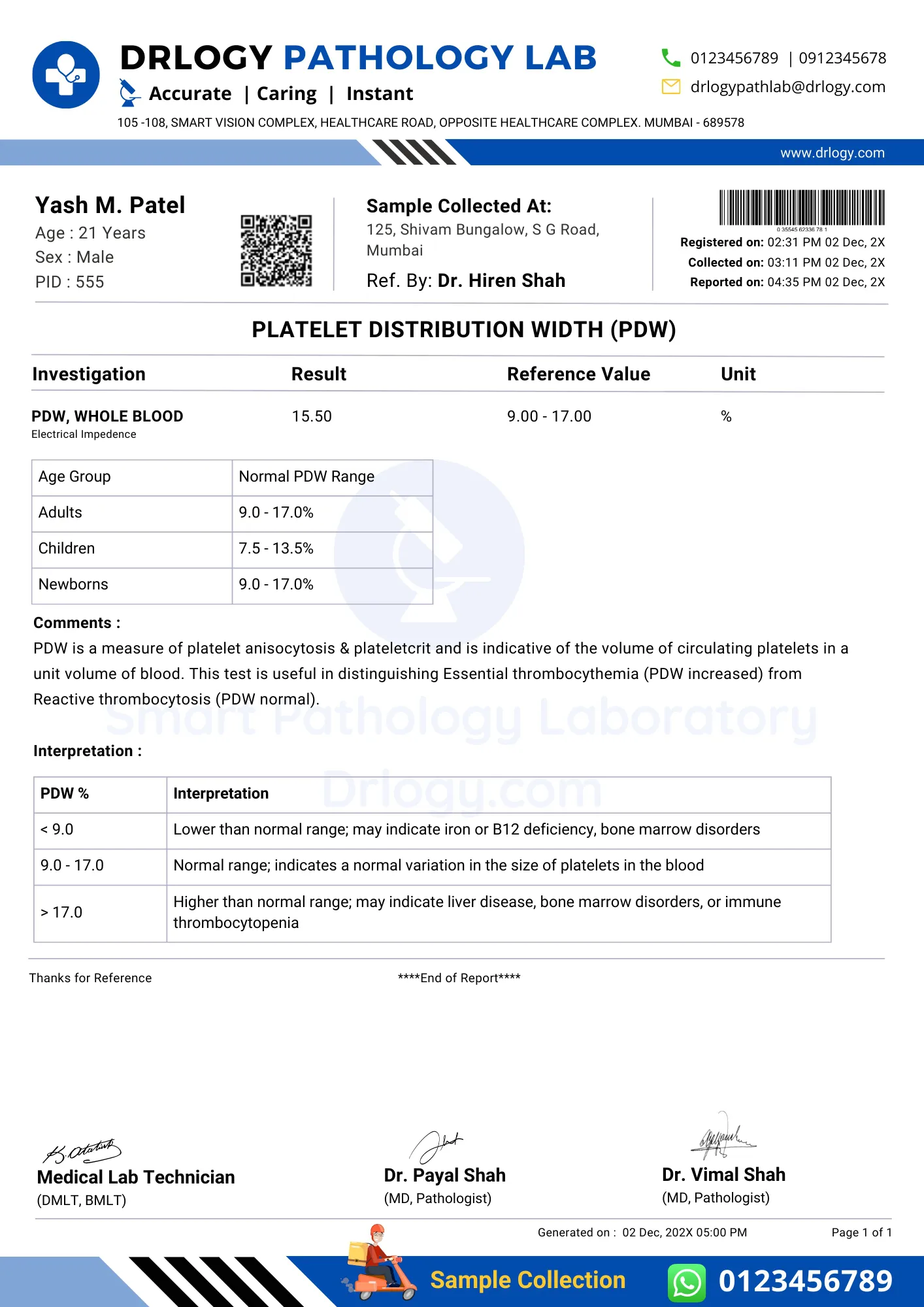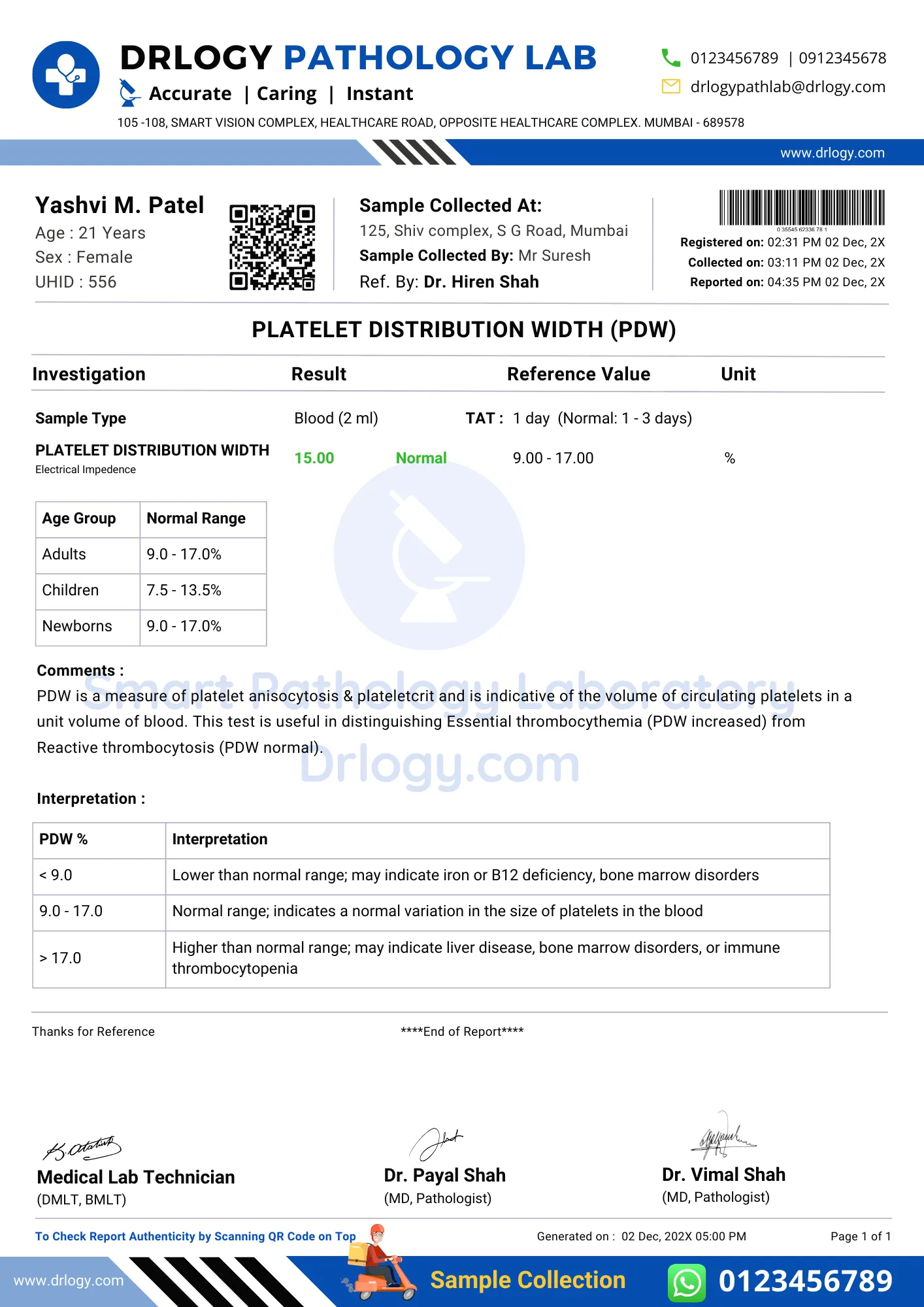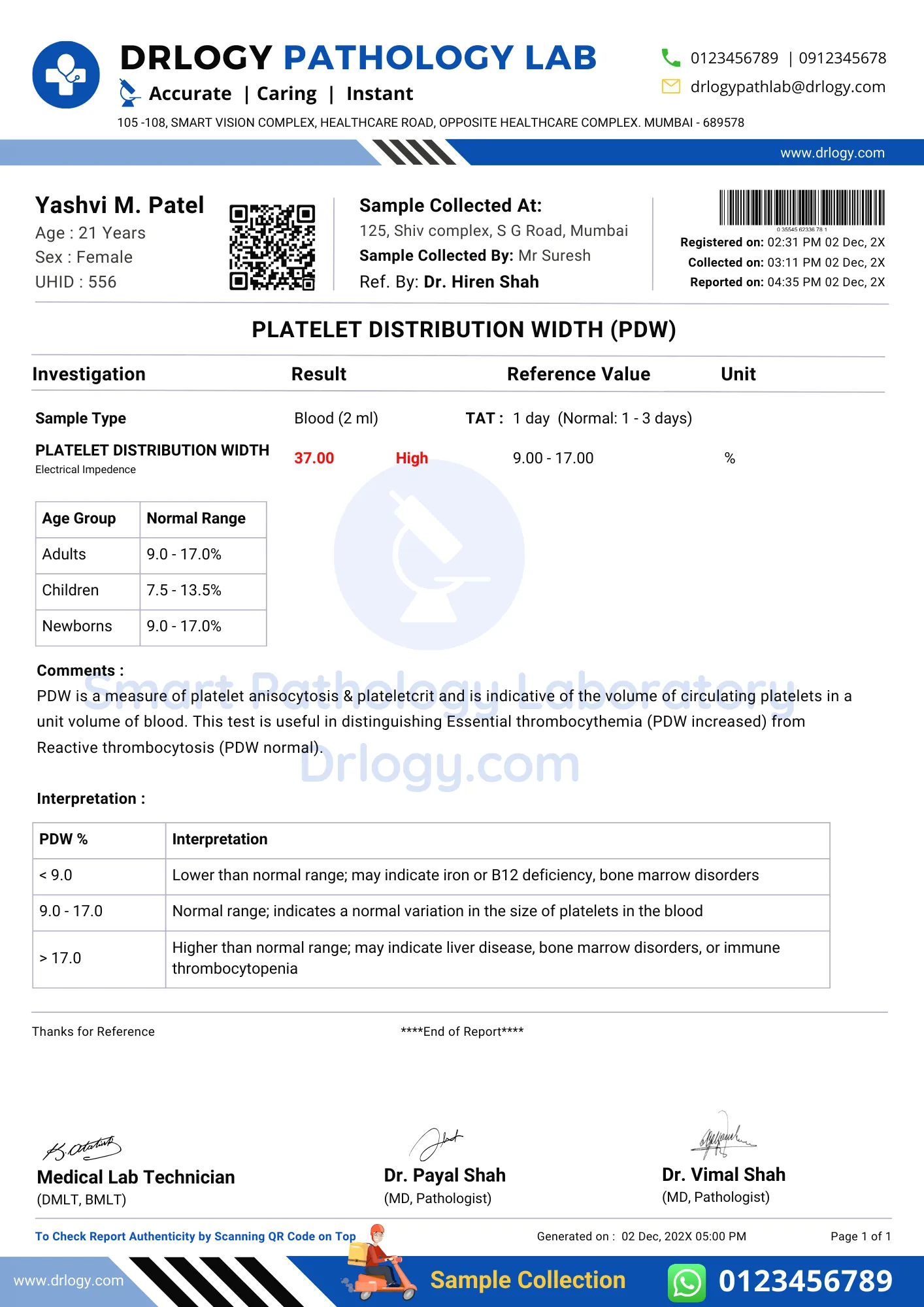
PDW (platelet distribution width) blood test is used to measure the variation in size and distribution of platelets in the blood. This information can be helpful in diagnosing certain medical conditions, such as bone marrow disorders, vitamin deficiencies, or viral infections.
Here are the basic details for PDW Blood Test.
| Also Known As | Platelet Width Distribution Test |
| Type | Blood Test |
| Purpose |
Measure Platelets Size in Blood |
| Sample Type | Blood |
| Preparation | No Special Preparation Required |
| Fasting | No |
| Gender | Unisex |
| Age-Group | All Ages |
| Normal Value | 9 - 17 % |
| Reporting Time | 1 - 2 hours |
| Cost | 100 - 200* INR |
*Price range may vary as per location, lab type, and procedure of lab test.
Interesting Facts About Platelets
- Platelets are small, colorless cells in the blood involved in clotting.
- They are formed in the bone marrow from larger cells called megakaryocytes.
- Platelets help control bleeding by forming a plug at the site of blood vessel injury.
- They release chemical signals that attract other platelets and help in the formation of a stable clot.
- Abnormal platelet counts or function can lead to bleeding or clotting disorders.
Here are some key points on the purpose of a PDW blood test:

Here are the preparation steps for a PDW blood test:
Summary
Prepare for a PDW blood test by following fasting instructions, staying hydrated, and applying pressure after the test to the puncture site.
Here is basic procedure of PDW Blood Test.
Here are some key points for interpreting PDW blood test results:


PDW Blood Test Normal Report PDF

PDW Blood Test Abnormal Report PDF
here's a table showing the normal range of PDW values in percentage (%):
| Age Group | Normal PDW Range |
|---|---|
| Adults | 9.0% - 17.0% |
| Children | 7.5% - 13.5% |
| Newborns | 9.0% - 17.0% |
It's worth noting that the normal range may vary slightly depending on the laboratory that performs the test. Additionally, the normal range may differ for certain populations, such as pregnant women or people with certain medical conditions.
PDW blood test results are typically reported as a percentage (%). Here's an example table showing how PDW values might be interpreted:
| PDW Value | Interpretation |
|---|---|
| < 9.0% | Lower than normal range; may indicate iron or B12 deficiency, bone marrow disorders |
| 9.0% - 17.0% | Normal range; indicates a normal variation in the size of platelets in the blood |
| > 17.0% | Higher than normal range; may indicate liver disease, bone marrow disorders, or immune thrombocytopenia |
It's important to note that interpreting PDW values should always be done in the context of an individual's medical history and other blood test results.
Here are the specimen requirements for PDW Blood Test.
| Specimen | Whole Blood |
| Volume | 5-10 mL |
| Container | Sterile tube or vial with anticoagulant |
Here are the possible causes of a High PDW (platelet distribution width) value.
| Condition or factor | Description |
|---|---|
| Liver disease | Liver disease, such as cirrhosis, can cause an increase in PDW values. |
| Bone marrow disorders | Disorders that affect the bone marrow, such as myelodysplastic syndrome or leukemia, can cause changes in platelet size and distribution, resulting in high PDW values. |
| Immune thrombocytopenia | This is a condition where the immune system attacks and destroys platelets, leading to low platelet counts and high PDW values. |
| Vitamin B12 deficiency | Vitamin B12 is necessary for proper platelet formation, and a deficiency in this vitamin can lead to changes in platelet size and distribution. |
| Folate deficiency | Folate is another vitamin that is essential for platelet formation, and a deficiency can lead to changes in platelet size and distribution. |
| Iron deficiency anemia | Iron is necessary for the production of hemoglobin, which is a component of red blood cells. Anemia due to iron deficiency can affect platelet size and distribution, leading to high PDW values. |
Here are the possible causes of a low PDW (platelet distribution width) value.
| Condition or factor | Description |
|---|---|
| Iron deficiency anemia | Iron is necessary for the production of hemoglobin, which is a component of red blood cells. Anemia due to iron deficiency can affect platelet size and distribution, leading to low PDW values. |
| Vitamin B12 deficiency | Vitamin B12 is necessary for proper platelet formation, and a deficiency in this vitamin can lead to changes in platelet size and distribution, resulting in low PDW values. |
| Folate deficiency | Folate is another vitamin that is essential for platelet formation, and a deficiency can lead to changes in platelet size and distribution, resulting in low PDW values. |
| Bone marrow disorders | Disorders that affect the bone marrow, such as aplastic anemia or myelodysplastic syndrome, can cause changes in platelet size and distribution, leading to low PDW values. |
| Chemotherapy or radiation therapy | These treatments can affect the bone marrow and interfere with platelet production, leading to changes in platelet size and distribution, resulting in low PDW values. |
| Viral infections | Some viral infections, such as HIV or hepatitis C, can affect platelet production and distribution, leading to low PDW values. |
Summary
High PDW levels may indicate platelet activation or certain medical conditions, while low levels can be associated with decreased platelet production or other underlying health issues.
Yes, a PDW (platelet distribution width) blood test is generally considered safe. Here are some points to keep in mind:
Here are some possible limitations of the PDW Blood Test.
Here is the potential risk factor of the PDW Blood Test.
Here are Doctor recommendations or consult a specialist after PDW Blood Test.
| PDW Result | Doctor to Visit | Reason to Go |
|---|---|---|
| High | Hematologist | Evaluate platelet disorders or bone marrow conditions |
| Normal | Primary Care Physician | Routine follow-up or general health assessment |
| Low | Hematologist | Investigate potential bleeding or clotting disorders |
Here are the estimated PDW Blood Test Price in India with different top cities:
| City | Price Range (INR)* |
|---|---|
| Mumbai | 100 - 200 |
| New Delhi | 100 - 200 |
| Bangalore | 100 - 200 |
| Hyderabad | 100 - 200 |
| Kolkata | 100 - 150 |
| Pune | 100 - 150 |
| Lucknow | 100 - 200 |
| Noida | 100 - 200 |
| Surat | 100 - 150 |
| Gurugram | 100 - 150 |
| Patna | 100 - 200 |
| Chennai | 100 - 150 |
| Jaipur | 100 - 200 |
| Ahmedabad | 100 - 150 |
*Prices are approximate and vary depending on a specific laboratory or healthcare facility.
Summary
Overall, PDW (platelet distribution width) blood test is a safe and simple procedure that can provide information about platelet size and distribution, which can be useful in diagnosing certain medical conditions. Also check Drlogy Test for detailed information about all medical tests for patients, doctors, scholers and medical students.
Reference
PDW stands for Platelet Distribution Width, which is a measure of the variation in platelet size in the blood.
The PDW blood test is typically included as part of a complete blood count (CBC) or platelet function evaluation.
The PDW blood test is performed by taking a blood sample, usually from a vein in the arm.
The PDW value is reported as a percentage or a numerical value, which represents the degree of variation in platelet size.
DOCTOR'S MOST TRUSTED HEALTHCARE PLATFORM
10M+
Patients
30000+
Doctors
25000+
Hospitals/Labs